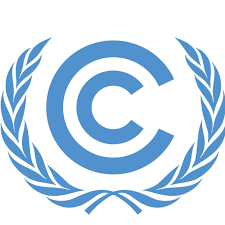- Exhibition space
- United Nations

United Nations
The United Nations Framework Convention on Climate Change (UNFCCC) established an international environmental treaty to combat "dangerous human interference with the climate system", in part by stabilizing greenhouse gas concentrations in the atmosphere. It was signed by 154 states at the United Nations Conference on Environment and Development (UNCED), informally known as the Earth Summit, held in Rio de Janeiro from 3 to 14 June 1992. Its original secretariat was in Geneva but relocated to Bonn in 1996. It entered into force on 21 March 1994.
The treaty called for ongoing scientific research and regular meetings, negotiations, and future policy agreements designed to allow ecosystems to adapt naturally to climate change, to ensure that food production is not threatened and to enable economic development to proceed in a sustainable manner.
Climate finance refers to local, national or transnational financing—drawn from public, private and alternative sources of financing—that seeks to support mitigation and adaptation actions that will address climate change. The Convention, the Kyoto Protocol and the Paris Agreement call for financial assistance from Parties with more financial resources to those that are less endowed and more vulnerable. This recognizes that the contribution of countries to climate change and their capacity to prevent it and cope with its consequences vary enormously. Climate finance is needed for mitigation, because large-scale investments are required to significantly reduce emissions. Climate finance is equally important for adaptation, as significant financial resources are needed to adapt to the adverse effects and reduce the impacts of a changing climate.
In accordance with the principle of “common but differentiated responsibility and respective capabilities” set out in the Convention, developed country Parties are to provide financial resources to assist developing country Parties in implementing the objectives of the UNFCCC. The Paris Agreement reaffirms the obligations of developed countries, while for the first time also encouraging voluntary contributions by other Parties. Developed country Parties should also continue to take the lead in mobilizing climate finance from a wide variety of sources, instruments and channels, noting the significant role of public funds, through a variety of actions, including supporting country-driven strategies, and taking into account the needs and priorities of developing country Parties. Such mobilization of climate finance should represent a progression beyond previous efforts.
It is important for all governments and stakeholders to understand and assess the financial needs of developing countries, as well as to understand how these financial resources can be mobilized. Provision of resources should also aim to achieve a balance between adaptation and mitigation.
Overall, efforts under the Paris Agreement are guided by its aim of making finance flows consistent with a pathway towards low greenhouse gas emissions and climate-resilient development. Assessing progress in provision and mobilization of support is also part of the global stocktake under the Agreement. The Paris Agreement also places emphasis on the transparency and enhanced predictability of financial support.
What is the financial mechanism? What are the other funds?
To facilitate the provision of climate finance, the Convention established a financial mechanism to provide financial resources to developing country Parties. The financial mechanism also serves the Kyoto Protocol and the Paris Agreement.
The Convention states that the operation of the financial mechanism can be entrusted to one or more existing international entities. The Global Environment Facility(GEF) has served as an operating entity of the financial mechanism since the Convention’s entry into force in 1994. At COP 16, in 2010, Parties established the Green Climate Fund (GCF) and in 2011 also designated it as an operating entity of the financial mechanism. The financial mechanism is accountable to the COP, which decides on its policies, programme priorities and eligibility criteria for funding.
In addition to providing guidance to the GEF and the GCF, Parties have established two special funds—theSpecial Climate Change Fund (SCCF) and the Least Developed Countries Fund (LDCF), both managed by the GEF—and the Adaptation Fund (AF) established under the Kyoto Protocol in 2001.
At the Paris Climate Change Conference in 2015, the Parties agreed that the operating entities of the financial mechanism – GCD and GEF – as well as the SCCF and the LDCF shall serve the Paris Agreement. Regarding the Adaptation Fund serving the Paris Agreement negotiations are underway in the Ad hoc Working Group on the Paris Agreement (APA).
What is the Standing Committee on Finance? What is the long-term finance process?
Standing Committee on Finance
At COP 16 in 2010, Parties decided to establish the Standing Committee on Finance (SCF) to assist the COP in exercising its functions in relation to the financial mechanism of the Convention.
Currently, the SCF has four specific functions: assisting the COP in improving coherence and coordination in the delivery of climate change financing; assisting the COP in rationalization of the financial mechanism of the UNFCCC; supporting the COP in the mobilization of financial resources for climate financing; and supporting the COP in the measurement, reporting and verification of support provided to developing country Parties. The Committee is also tasked to organize an annual forum on climate finance, provide the COP with draft guidance for the operating entities, provide expert input into the conduct of the periodic reviews of the financial mechanism and prepare a biennial assessment and overview of climate finance flows. Furthermore, the SCF is designed to improve the linkages and to promote the coordination with climate finance related actors and initiatives both within and outside of the Convention. At the Paris Conference in 2015, Parties decided that the SCF shall also serve the Paris Agreement.
Long-term climate finance
The long-term finance process is aimed at progressing on the mobilization and scaling up of climate finance of resources originating from a wide variety of sources, public and private, bilateral and multilateral, including alternative sources. The COP decided on the following activities through to 2020: organization, by the secretariat, of annual in-session workshops; developed countries providing, on a biennial basis, information on strategies and approaches for scaling up climate finance; and convening of biennial high-level ministerial dialogue on climate finance.
Through the Cancun Agreements in 2010 developed country Parties committed, in the context of meaningful mitigation actions and transparency on implementation, to a goal of mobilizing jointly USD 100 billion per year by 2020 to address the needs of developing countries. When adopting the Paris Agreement Parties confirmed this goal, called for a concrete road map to achieve the goal by 2020, and agreed that prior to 2025 the Conference of the Parties serving as the meeting of the Parties to the Paris Agreement (CMA) shall set a new collective quantified goal from a floor of USD 100 billion per year.
What is the finance portal?
The UNFCCC website includes aclimate finance data portal with helpful explanations, graphics and figures for better understanding the climate finance process and as a gateway to information on activities funded in developing countries to implement climate action. The finance portal comprises three modules, each of which includes information made available by Parties and the operating entities of the financial mechanism.
The first module, the National Communications Module, presents information communicated by contributing countries on the provision of financial resources, in the context of regular reporting to the Convention. The second module, the Fast-start Finance Module, includes information on resources provided by developed countries in the context of their commitment to provide approximately USD 30 billion over the period 2010–2012. The third module, on Funds Managed by the GEF, is a joint effort between the secretariat of the UNFCCC and the GEF and contains information on climate finance flows of the GEF in its role as one of the operating entities of the financial mechanism to the Convention. Additionally, information on projects and programmes of the Adaptation Fund can be found in the finance portal. This fund was established under the Kyoto Protocol to finance concrete adaptation projects and programmes in developing countries that are Parties to the Kyoto Protocol.
What are climate technologies?
Technologies that we use to address climate change are known as climate technologies. Climate technologies that help us reduce GHGs include renewable energies such as wind energy, solar power and hydropower. To adapt to the adverse effects of climate change, we use climate technologies such as drought-resistant crops, early warning systems and sea walls. There are also ‘soft’ climate technologies, such as energy-efficient practices or training for using equipment.
What is technology transfer to support climate action?
Developing and transferring technologies to support national action on climate change has been an essential element from the beginning of the UNFCCC process. In 1992, when countries established the Convention, they included specific provisions on technology with the aim of achieving the ultimate objective of the Convention. The Convention notes that all Parties shall promote and cooperate in the development and transfer of technologies that reduce emissions of GHGs. It also urges developed country Parties to take all practicable steps to promote, facilitate and finance the transfer of, or access to, climate technologies to other Parties, particularly to developing countries. Furthermore, the Convention states that the extent to which developing country Parties will effectively implement their commitments will depend on the effective implementation by developed country Parties of their commitments under the Convention related to financial resources and transfer of technology.
Over the years, technology development and transfer with regard to adaptation has received increasing attention. The Paris Agreement speaks of the vision of fully realizing technology development and transfer for both improving resilience to climate change and reducing GHG emissions. It establishes a technology framework to provide overarching guidance to the Technology Mechanism.
What are the key institutions and mechanisms?
Technology Mechanism
In 2010 the COP established the Technology Mechanism with the objective of accelerating and enhancing climate technology development and transfer. It consists of two complementary bodies that work together, – the Technology Executive Committee (TEC) and the Climate Technology Centre and Network (CTCN). The mechanism will also serve the Paris Agreement.
Technology Executive Committee
The TEC is the Technology Mechanism’s policy arm and analyses policy issues and provides recommendations to support countries in enhancing climate technology efforts. The TEC is an executive committee consisting of 20 technology experts representing both developing and developed countries. The TEC meets multiple times a year and holds climate technology events that support efforts to address key technology policy issues.
The Climate Technology Centre and Network
The CTCN is the mechanism’s implementation arm and it supports countries to enhance the implementation of climate technology projects and programmes. It has three core services: providing technical assistance to developing countries; creating access to knowledge on climate technologies; and fostering collaboration among climate technology stakeholders. The CTCN is hosted by the United Nations Environmental Programme, in collaboration with the United Nations Industrial Development Organization, and is supported by 11 partner institutions with expertise in climate technologies. The Centre facilitates a network of national, regional, sectoral and international technology centres, networks, organizations and private sector entities. More than 150 Parties have submitted their national designated entities (NDEs) for climate technology and transfer, which are also part of the network. Developing country Parties may submit requests for technical assistance to the CTCN through their NDEs.
Technology Framework
Article 10, paragraph 4, of the Paris Agreement establishesd the Technology Framework. The framework will provide overarching guidance to the work of the Technology Mechanism in promoting and facilitating enhanced action on technology development and transfer in order to support the implementation of theis Agreement, in pursuit of the long-term vision on technology development and transfer referred to in Article 10, paragraph 1. Under the SBSTA countries are currently working to elaborate the details of the framework.
Technology needs assessments
Understanding our climate technology needs is the starting point for effective action on climate change. By understanding these needs we can determine how to reduce greenhouse gas emissions and adapt to the adverse impacts of climate change. To determine their climate technology priorities, countries undertake technology needs assessments (TNAs). A TNA supports national sustainable development, builds national capacity and facilitates the implementation of prioritized climate technologies. Since 2001, more than 85 developing countries have undertaken TNAs to identify their technology needs for mitigation and adaptation. Since 2010, as part of their TNAs, developing countries have also developed technology action plans (TAPs), which are concrete action plans for the implementation of their prioritized technology needs. The GEF provides support for developing countries to undertake TNAs through its Poznan Strategic Program on Technology Transfer.
Science: why is there a need to act?
Scientists, researchers, and affected peoples around the world report changes beyond the natural variation of temperatures on land and in the ocean, as well as abnormal trends in the timing of seasons, in rainfall patterns, and in many other systems. The science on climate change is clear. There is no question that these abnormal changes result from global warming due to an increased greenhouse effect caused by the vast amounts of greenhouse gases added to the atmosphere by human activities.
In response to this, an international climate regime has developed. Governments, intergovernmental organisations, non-governmental organisations, businesses, research bodies, civil society and more are working together to build the science and knowledge that allow us to tackle the causes and threats of climate change. Key underlying facts are:
- The concentration of GHGs has been rising steadily since the time of the Industrial Revolution as a result of human activity, primarily the burning of fossil fuels and changes in land use, leading to increasing global temperatures.
- The average global temperature on Earth is directly linked to the concentration of GHGs in the atmosphere. Small rises in temperature have major impacts on weather and climate systems, causing detrimental impacts for life and society.
- Urgent action is needed to mitigate additional emissions, reduce the GHGs concentration in the atmosphere, and to adapt to the current and future impacts of climate change.
Climate science in the UNFCCC
The knowledge of the causes and impacts of climate change is constantly growing in breadth and depth, based on Earth observations and scientific research by a large number of organizations and thousands of scientists from around the world. All action under the UNFCCC process is based on the best available science - the latest research and observations from organisations such as the Intergovernmental Panel on Climate Change (IPCC) and the World Meteorological Organisation (WMO).
Science enters the process through a number of different UNFCCC workstreams, where it informs negotiations and guides workshops, dialogues, and other events. Three workstreams exist solely to facilitate meetings of experts and decision-makers, to determine whether the long term goal of the Paris Agreement is still fit for its purpose, and to coordinate with the IPCC.
Research and Systematic Observation (RSO) organises meetings of experts, Parties, and non-party stakeholders to facilitate dialogue on the latest and best available science and how to support its generation. Two meetings are held annually: the research dialogue and the Earth Information Day.
Periodic Review facilitates the technical assessment of Parties and experts to review the adequacy of the long-term global goal (limiting global average temperature increase to well below 2°C above pre-industrial levels and preferentially below 1.5°C) and the progress towards achieving it.
Cooperation with the IPCC works closely with the IPCC to ensure that Parties have the opportunity to consult and interact with IPCC authors, to coordinate the timing of events and engagements with respect to the release of IPCC reports, and to otherwise facilitate the IPCC's involvement as necessary within the UNFCCC process.












